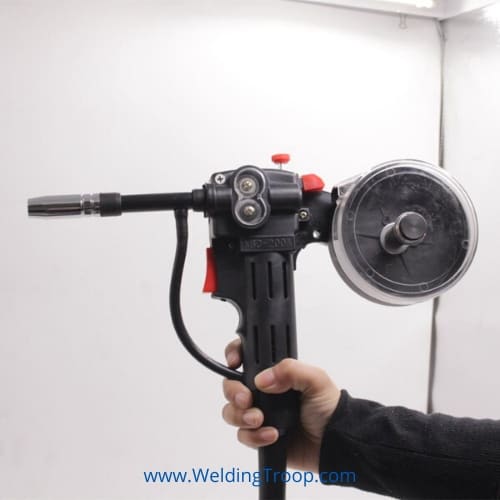Welding is a complex process that requires a lot of knowledge to do, and a lot of experience to do well. Once you figure out the proper tools, techniques, and equipment to weld steel, you are likely to want to give welding aluminum a try.
Do you need a spool gun to weld aluminum? No. There are other methods of welding aluminum that do not require a spool gun. Welding aluminum is a bit different than welding steel, but a good technique, the right tools, and an understanding of how it works will have you welding in no time.
Table of Contents
What is the Difference Between Welding Aluminum and Steel?
Using aluminum has become very popular in fabrication because of its lightweight, corrosion resistance, and overall strength. While it certainly has different properties than steel, it can hold its own in many ways. But what are those differences, and why are they important?
When welding aluminum or steel, their different melting points stand out. The melting point for aluminum is 1,221 degrees Fahrenheit, while some steel starts melting at 2,500 degrees. However, aluminum has an oxide layer on top that doesn’t melt until 3,700 degrees.
Unlike the oxide on steel, this is a significant difference from the temperature of the core metal. This means that the preparation method for aluminum is also significantly different than steel. If the oxide is not removed first, you will not get a solid weld.
Steel becomes more brittle as service temperatures decrease, but extreme cold only makes aluminum stronger. This is why aluminum is often used for liquid nitrogen containers.
Steel is an alloy that uses mostly iron. Aluminum alloys are primarily made of aluminum but have a variety of elements like copper, zinc, or magnesium added to it for different final product purposes. However, pure aluminum is also still used.
Because of these differences, those used to welding steel are often challenged when first attempting to weld aluminum. Some of those challenges are overcome with the use of a spool gun, but there are other ways.
Why Would You Need a Spool Gun?
There is a lot of push in the welding community to use a spool gun for welding aluminum. But why is that? The simple answer is the ease of use. Spool guns that are designed for aluminum wire eliminate some of the challenges aluminum welders face.
But what are those challenges, and how does a spool gun help? The main culprit is wire feeding issues. When using aluminum wire fed through a welder, you can get what is called a “bird’s nest” when the wire binds up inside of the machine.

This is caused by a few issues that revolve around the fact that aluminum wire bends very easily.
- The strength of the wire cannot take the feed pressure. The feeder simply causes much more force than the wire can take while being fed. This can sometimes be related to the wire feed speed being too high.
- There is too much tension on the guides. If the guides press the wire too hard, the wire will begin to bind behind it rather than gliding between them.
- Bends in the hose. If the hose bends too sharply or too often, the friction will cause the wire to stop feeding.
- Burs or imperfections in the wire cause feed issues. If the wire has any spots that are rough and can snag, they most likely will.
The spool gun works a little bit differently than the machine-fed wire. Machines feed through guides in the welder, the hose, and then through the handle before making contact.
The spool gun is a removable handle that holds the spool in the back of it. Using a spool gun means you bypass the machine and hose altogether, causing less friction and binding points.
Here is a video that demonstrates how the spool gun works in a lot more detail. How To Weld With A Spool Gun >> Check out the video below:
Read also >> 6 reasons why it is difficult to weld aluminum?
Read also >> Can You Weld Aluminum With an Arc Welder? All You Need to Know
Read also >> Can MIG Welders Weld Aluminum? | How to successfully weld Aluminum?
Read also >> How to Weld Aluminum at Home >> A Beginner’s Guide
Welding Aluminum Without a Spool Gun
Whenever you are doing something like welding without a tool designed to make it easier, it is important to remember that the small things matter.
- Make sure you are using the proper gas for aluminum. Pure Argon or an Argon and Helium mix will be needed.
- Set your welder properly. The thickness of your aluminum will determine what settings you will need for feeding, gas, and power.
- Prepare the surface. Make sure you remove the aluminum oxide, or you will have poor welds. When using a steel wire brush, be sure that brush has ONLY been used with aluminum to clean it properly.
1. MIG Welding
When it comes to specialty tools like MIG welders, the adage “You get what you pay for” rings true. If you want to be able to do high-quality work with both steel and aluminum, you will need to spend a little more. Buy a quality MIG welder and hoses to reduce the stress on the wire.
Before welding, try a few test pieces, so you are sure the feed is working properly. If you are having issues with bird nests, try placing your welder further away so you can have as straight of a hose as possible. If you still have issues, adjust the tension and feed speed to lower amounts to take away some of the resistance on the wire.
2. TIG Welding
TIG welding is a different piece of machinery with a different process. Where MIG welders feed the wire for you, welding aluminum with a TIG welder requires you to use your off-hand to feed your filler material.
Because of this, TIG welding is a little more complicated. You must be able to coordinate both hands to feed and travel at the proper rates. Additionally, welding longer beads with a TIG welder can be a bit slower than using a MIG Welder.
However, since you are not relying on a machine to push a very thin wire, you eliminate the friction and bird nest issues you may run into with a MIG welder.
For a detailed TIG welding explanation and demonstration, check out this video.
3. Torch “Welding”
An oxy-acetylene torch is a fun and useful tool. However, despite many people calling it torch welding, using a torch isn’t welding anything together. Instead, it is called “brazing” and isn’t used in anything that would carry heavy loads.
If your aluminum needs are purely superficial or for aesthetic purposes, this might be a good option for you.
What Equipment Do You Need?
With a lot of focus on equipment, how does someone know what to look for? Here are a couple of options that will improve your welding experience.
A MIG Welder for Every Job
If you are looking for the last welder you will ever need, the Lincoln Electric Power MIG might just be it. Capable of doing stick or wire welding, this unit will handle aluminum or steel with ease.
If You Prefer TIG
TIG welding is incredibly versatile and always growing in popularity. The AHP AlphaTIG will cover your TIG welding needs and give you options for stick welding as well!
Conclusion
While it may not be as easy, you do not need a spool gun to weld aluminum. Both quality MIG welders and experienced TIG welders have what they need to make great aluminum welds. With practice and patience, you can get a nice bead and a strong weld.
Recommended Reading
Can You Weld Aluminum Without Gas? Is It Possible?
How to Weld Aluminum at Home >> A Beginner’s Guide
Can Steel and Aluminum Be Welded Together?| All You Need To Know

